– 2016 Honda Dual Sport Motorcycle Review / CRF250L –
The Honda CRF250L remains unchanged for 2016. It was originally introduced in 2013 and has been a huge hit ever since due to its reliability and bang for the buck when compared to other dual sport motorcycles on the market from Yamaha, Suzuki, Kawasaki etc. A lot of us were hoping for 2016 to bring a CRF300L from Honda but that’s a no-go this year and probably with good reason as it would have jumped the price up a pretty good bit and part of the allure with the 250L is how affordable it is.
Contents:
- 1 Introduction
- 2 Model overview
- 3 Key features
- 4 Quick overview (for those in a hurry)
- 5 Technical specifications
1. CRF250L Introduction
The essence of what makes a true dual-purpose motorcycle has long been in Honda’s DNA. In the late 1970s the XL250S was launched, a four-stroke four-valve overhead-cam single-cylinder street/dirt bike in an era dominated by two-strokes. At the time, highly regarded Cycle magazine said of the XL250, ” No more than you would expect from Honda, and no less: An absolutely brilliant, inspired engine, superb styling, careful detailing… ” They provided genuine on-road usability with excellent off-road performance. The entire XL range that followed became legendary, and proved that bolting an economical and easy-to-use single-cylinder four-stroke engine into a competent chassis, created a bike that was useful, versatile and, as riders the world over found, fun.
Riders responded to the XL250 with a rush, a generation set for fun and affordability scooped up more than 80,000 of these machines over the course of its run. Subsequent generations of models were strong testimony to the popularity of these versatile, fun-to-ride dual-sport machines.
Flash forward 40 years, and Honda introduces our newest dual-sport bike with the CRF250L. The generation that became part of motorcycling in the 70’s and 80’s are still riding and new generation X and Y are looking to enter motorcycling. Thanks to a very affordable price, fuel economy estimated at 73 mpg, plus the ease of use, convenience and practicality of an electric-start everyday rider, the CRF250L is an incredible value with it’s MSRP at only $4,999. This is a great motorcycle for the existing customer to add to their ownership and for a new rider just getting started in the sport.
Exhaustive discussions within Honda R&D took place about the creation of a brand new dual-purpose machine. The company’s long history – in off-road competition and dual-purpose machinery – was a useful touchstone when development of the bike first began, and inspired the team that worked on it from the outset.
Looking to the needs of customers came first. While some riders insist upon competition-level off-road performance, many others value ease of use, practicality and convenience. For weekday, urban use they wanted a tough, practical bike with cutting-edge off-road style. But, come the weekend, it needed to provide a ticket to ride, wherever they wanted to go, on or off-road.
Honda’s new dual-purpose platform was always viewed by its development engineers with global perspective, as a bike for the whole world. It not only needed a powerful and frugal engine, its chassis also had to have a broad and capable range. The bike was to be affordable, offering high quality and outstanding value for money, with low overall running costs a priority.
Perhaps most important, and a driving force for the engineers working exhaustively to deliver such a multi-faceted motorcycle, was to produce something that could connect many people to Honda, and help them realize their dreams in a way that only a motorcycle can.
The CRF250L is that motorcycle.
2. CRF250L Model Overview
The CRF250L is a dual-purpose motorcycle. Its dimensions, ergonomics, low weight, long-travel 43mm Showa USD forks and Pro-link rear suspension make it equally at home on city streets or country trails. The single-cylinder engine provides useful power and torque across a wide rev range, with excellent fuel economy. The crisp styling takes cues from the legendary CRF competition range, and, as expected from Honda,both build quality and engineering standard is high.
The key phrase used throughout CRF250L development was: “…to make ‘On’ (daily life) more convenient and ‘Off’ (weekends) more enjoyable!”
3. CRF250L Key Features
3.1 Engine
At the core of the CRF250L beats a heart suited for the global market: like the popular CBR250R, this is a bike manufactured in Honda’s Thailand production facility and the two bikes share the same basic engine architecture. This new-generation four-stroke liquid-cooled 249.6cc single-cylinder powerplant features a dual overhead camshaft layout for improved combustion efficiency, thanks to the reduced weight of the reciprocating valve train, large valves (30mm intake and 24mm exhaust) with thin stems for superior flow, and a centrally located spark plug for efficient flame propagation. This design also permitted great freedom in choosing the narrow included valve angle, port shape, and a pent-roof combustion chamber—all key elements for optimal performance.
The CRF250L engine team came up with a new and extremely compact roller/rocker arm design for the low-friction valve train. A roller rocker arm is used in combination with the DOHC engine configuration, which allows for a low-friction valve train and a very compact cylinder head, plus an ultra-compact layout for the roller rocker arm. The application of a shim design for valve tappet adjustment reduces rocker arm weight, while internal engine friction is further reduced by setting the valve spring load to a low level. An iridium spark plug, along with precise metering of fuel from the PGM-FI injection system, further enhances combustion efficiency and improves environmental credentials. For ease of maintenance and reduced operating costs, the valve shims can be replaced for valve adjustment maintenance without removing the camshafts.
The oversquare, short-stroke engine with a bore and stroke of 76mm by 55mm promotes engine responsiveness. To reduce reciprocating weight and friction, the piston carries a very short skirt and features a slick molybdenum coating. Friction was further reduced through the application of light striations on the piston to facilitate retention of lubricating engine oil, lowering the tension of the piston rings, and applying a smooth, shot-peen hardened finish to the piston pin. The CRF250L’s lightweight and compact liquid-cooled single-cylinder 249cc DOHC engine produces smooth and consistent torque at low rpm, aiding rear wheel traction and rider feel. Equally, the short stroke (76x55mm) engine’s high RPM performance is excellent; throughout its rev range and provides well-balanced and very usable power delivery.
Another slick bit of design insight further reduces engine friction: the cylinder centerline is offset from the center of the crankshaft, 4mm toward the exhaust side. Doing so reduces the lateral resistance generated between the piston and the cylinder during the power stroke. Also, to reduce the flow of blow-by gasses and minimize oil consumption, a spiny sleeve design was adopted for the cylinder sleeve. With this configuration, small spines have been added to the outer surface of the cylinder sleeve to improve cooling performance and help reduce distortion of the cylinder’s inner shape. In addition, centrifugal casting allowed a thin, uniform wall thickness, which aids weight reduction.
While the CRF250L and CBR250R share engine architecture, the CRF250L incorporates a number of unique elements that enhance its off-road capabilities—changes that place a premium on a broad spread of low-end and midrange torque over high-revving power. To that end, the CRF250L has been tuned for a more tractable powerband with its own ECU to control ignition and EFI mapping; new airbox; new intake manifold with a straighter path from the airbox to the cylinder head; a head pipe that’s smaller in diameter (down from 31.8mm in the CBR250R to 28.6mm) but about 200mm longer; a new muffler; and a smaller throttle body. The smaller 36mm throttle body for the Programmed Fuel Injection (PGM-FI) system (the street-only CBR250R uses a 38mm throttle body) yields higher airflow velocities in the intake tract, especially at lower engine speeds, which is just the ticket for slower-speed maneuvering in off-road applications. To create a tractable engine across such a broad rev range, much research and development effort went into the intake and exhaust system. The ideal internal dimensions were found for the throttle body and exhaust pipe, both in terms of diameter and length. A new design of viscous air filter and large 5.7L air box has been employed to maximize airflow. Other changes made for the CRF250L’s off-road applications include a new clutch with a judder spring to absorb shock loads through the driveline, plus a dirt-tough gearbox with wider gears and strengthened dogs. The internal gear ratios remain unchanged from those in the CBR250R, but lower final gearing is achieved via a 40-tooth rear-wheel sprocket in lieu of a 38-tooth sprocket. –
The new-generation crankshaft incorporates a metal bearing (half-split, press-fit) for the crank journal, and a cast-iron bushing supports the crank bearing, which improves the rigidity of the crankcase housing and better controls changes in the crank journal’s oil clearance arising from thermal expansion, while improving engine quietness at the same time. The built-up type crankshaft allows the big end of the connecting rod to use a low-friction roller bearing, and a primary balancer shaft is incorporated into this cutting-edge single-cylinder engine. It’s placed so close to the crankshaft that the balancer weight passes between the two crank weights—a design that keeps the engine as compact as possible while helping improve mass centralization. Also, crankshaft rigidity is enhanced further and quietness is improved by placing the engine counterbalancer’s driving gear on the right cover inside the clutch housing—a design that narrows the distance between the left/right crank bearings and efficiently places a load-bearing ball bearing at the tip of the crankshaft’s right side. Reducing internal frictional losses, the CRF250L engine uses an offset cylinder while the piston itself incorporates a special surface material, plus a molybdenum coating. The oil pump features an internal relief structure that prevents aeration of relieved oil.
A first for Honda in a single-cylinder off-road engine is the crank journal. It employs a half-split, press-fit metal bearing while the crank bearing uses a cast-iron bush. The net result of this new design reduces weight and makes for a smoother engine; it strengthens the rigidity of the case housing and minimizes the internal diameter change due to thermal expansion. A primary balance shaft further reduces vibration. The new six-speed gearbox and clutch were designed in conjunction and strengthened to cope with the extra stress riding off-road can produce.
The cooling system uses a 10.7 kW heat-release radiator, sited on the left of the bike, protected with a polypropylene grill baffled to improve airflow. A thin guide-ring cooling fan is used to maintain even temperatures at low speeds, either in congested traffic or tricky off-road situations.
To deal with Euro III emissions regulations an O2 Lambda sensor works in conjunction with a secondary air injection system. The catalyzer is sited inside the tapered exhaust muffler.
- 2016 CRF250L HP / Horsepower: 22.8
- 2016 CRF250L lb ft TQ: 16.2
- 2016 CRF250L MPG / Miles Per Gallon: 73
3.2 Chassis / Frame
To fulfill its dual-sport requirements, the CRF250L features a frame unique to this model. Constructed from steel, the frame’s twin oval-section main spars and semi-double cradle layout provide the strength needed for off-road riding. The slim and compact dimensions allow for a narrow rider interface that’s well suited to off-road work. A lightweight, round-section steel bolt-on subframe supports the rider plus a passenger, and guards located above the rider’s footpegs protect the frame from boot scuffs.
A wheelbase of 1,445mm is matched to a 27.6°’ rake with 113mm trail, giving excellent stability and agility.
The 43mm Showa inverted fork is suitably stout for off-road work, and there’s a full 9.8 inches of travel for use over a wide range of terrain and speeds. The Honda Pro-Link rear suspension delivers 9.4 inches of rear-wheel travel; the Showa shock absorber is a single tube design with 40mm diameter cylinder. The tapered aluminum swingarm incorporates a monoblock casting, a process that allows for the creation of intricate shapes and variable thicknesses suitable for this particular application. It provides the correct balance between rigidity, controlled flex, strength and reduced mass. Extruded aluminum is used for the chain adjustment collar.
The front brake uses a single 256mm disc gripped by a twin-piston caliper, while the rear incorporates a 220mm disc and single-piston caliper for strong stopping power. Braking has been tuned to offer excellent feel with a high level of controllability. The lightweight brake discs feature a wave design taken from the CRF250R and CRF450R, with exceptional self-cleaning abilities in adverse conditions.
Lightweight aluminum rims with straight-pull spokes further reduce unsprung mass. The directly attached spoke pattern layout is taken from the CRF250R / CRF450R and benefits from extreme rigidity. Block pattern enduro-style tires (front: 3.00-21 51P, rear: 120/80-18 62P) provide traction in a wide range of riding situations. The 21 inch front wheel and 18 inch rear increase stability on rough terrain and allow the fitment of a wide variety of off-road-specific tires possible.
3.3 Equipment/Styling
The CRF250L’s digital instrument cluster contains a fuel meter, with built-in clock and twin trip functions. The headlight visor provides visual CRF-inspired styling, protects the instruments and houses an H4 60W/55 bulb.
Overall styling of the CRF250L owes much to the elements of the competition CRF-R range, incorporating principles of mass centralization and triangular proportion. Ergonomic considerations were also a key factor, as the bike is required to perform, handle well, and be comfortable in a wide variety of conditions. The braced handlebar provides an upright and relaxed riding position, with plenty of leverage for bike control, and a 45° turning angle either side give a tight turning circle which is useful for dealing with urban traffic or tight trails.
The slim fuel tank holds 2 gallons, and combined with the comfortable, flat seat offers maximum control and choice of riding position. A compact, lockable toolbox is sited at the base of the rear fender.
Like the thousands of dual-sport Honda 250cc four-strokes that came before, the new CRF250L capitalizes on a great idea and fulfills an open niche. Its off-road prowess tickles the imagination as riders dream up destinations off the beaten path, and its Honda quality and reliability, plus its low purchase price and operating costs make it easy to own for anyone with a sense of adventure.
Want to see what you can do to squeeze 100+ MPH top speed out of your CRF250L? Check out this CRF250L build with Yoshimura exhaust, DCR cams, Bazzaz programmer, custom airbox etc by Clicking Here.
In a hurry? Here’s some cliff-notes to save you some time if you don’t feel like reading all of the detailed information above…
Quick Overview of Features
Engine / Drivetrain
- – Horsepower rating: 22.8
- – Torque Rating: 16.2 lb ft
- – MPG / Miles Per Gallon: 73
- – Compact and sophisticated liquid-cooled DOHC 249cc single-cylinder four-stroke powerplant produces smooth and consistent torque at low rpm, plus excellent high-rpm performance.
- – Programmed Fuel Injection (PGM-FI).
- – New, extremely compact roller rocker arm design for the low-friction valve train allows the use of a smaller cylinder head.
- – Gear-driven counterbalancer shaft helps reduce vibrations for rider comfort.
- – Electric start for easy starting.
- – Lightweight aluminum crankcase.
- – Maintenance-free CD ignition.
- – Heavy-duty clutch offers smooth, progressive engagement.
- – Smooth-shifting, versatile six-speed transmission.
- – Heavy-duty O-ring–sealed chain for durability and reduced maintenance.
Chassis / Suspension
- – Brand-new chassis developed specifically for the CRF250L provides excellent handling and agility.
- – Lightweight semi-double-cradle high-tensile steel frame.
- – Strong 43mm inverted fork provides 9.8 inches of travel.
- – Pro-Link® single-shock rear suspension delivers 9.5 inches of rear-wheel travel.
- – Tapered aluminum swingarm.
- – Powerful wave-design 256mm front disc brake, and 220mm rear disc brake provide strong and consistent stopping power.
- – Strong, lightweight rims with straight-pull spokes.
Additional Features
- – CRF®-R-inspired bodywork and graphics.
- – Front 21-inch wheel and 18-inch rear wheel with lightweight aluminum rims.
- – Digital multi-function speedometer.
- – Lockable tool box.
- – Transferable one-year limited warranty; extended coverage available with a Honda Protection Plan.
- – Motocross-style seat is low and comfortable and allows maximum rider movement.
- – Durable front and rear steel sprockets.
- – High-quality handlebar with comfortable grips.
- – Quiet, USDA-qualified spark arrester/muffler.
- – Maintenance-free sealed battery.
4. 2016 CRF250L Technical Specifications
| Model: | CRF250L |
| Engine Type: | 249.6cc liquid-cooled single-cylinder four-stroke |
| Bore and Stroke: | 76.0mm x 55.0mm |
| Compression ratio: | 10.7:1 |
| Valve Train: | DOHC; four-valve |
| Induction: | PGM-FI, 36mm throttle body |
| Ignition: | Computer-controlled digital transistorized with electronic advance |
| Transmission: | Six-speed |
| Final Drive: | #520 chain; 14T/40T |
| Suspension | Front: 43mm inverted fork; 9.8 inches travel Rear: Pro-Link single shock; 9.5 inches travel |
| Brakes | Front: Single 256mm disc with twin-piston caliper Rear: Single 220mm disc |
| Tires | Front: 3.00-21 Rear: 120/80-18 |
| Wheelbase: | 56.9 inches |
| Rake (Caster angle): | 27°35’ |
| Trail: | 113mm (4.4 inches) |
| Seat Height: | 34.7 inches |
| Ground Clearance: | 10.0 inches |
| Fuel Capacity: | 2.0 gallons |
| Fuel Economy Estimate**: | 73 MPG |
| Color: | Red |
| Curb Weight*: | 320 pounds |









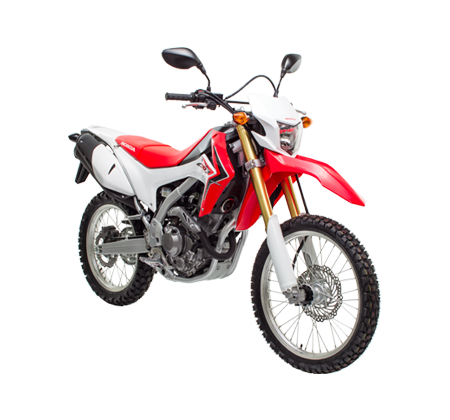

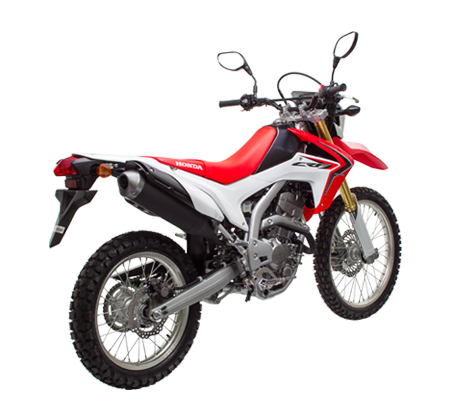
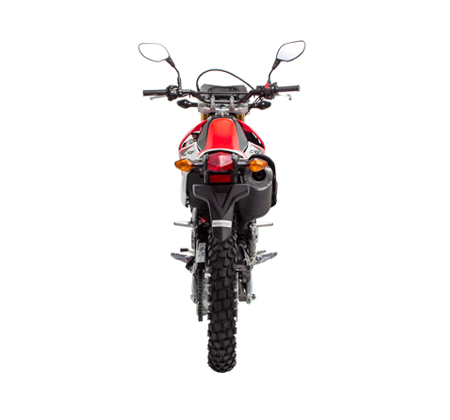
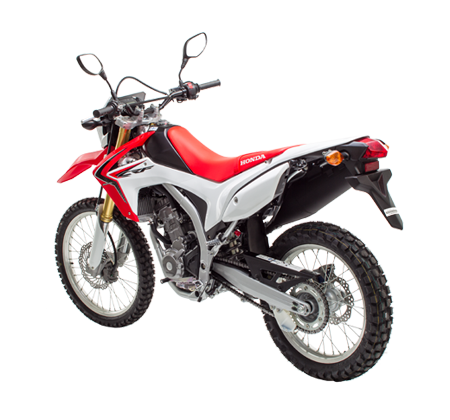
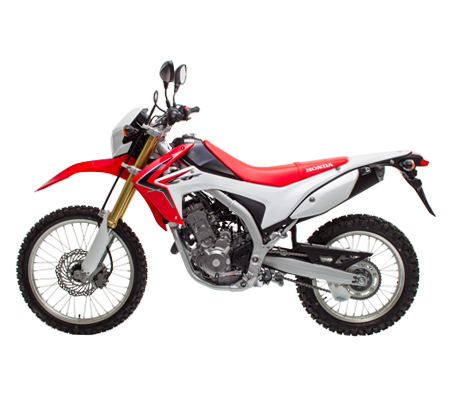
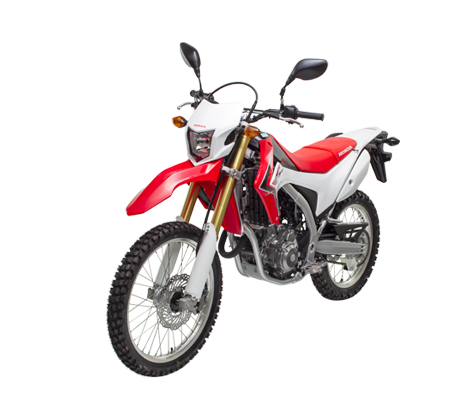
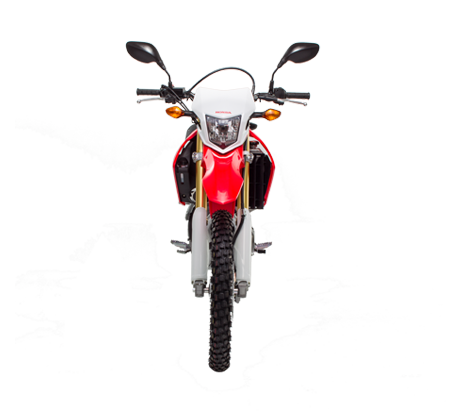
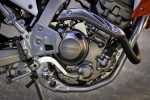
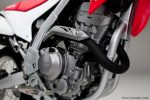
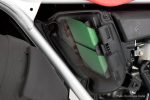
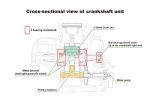
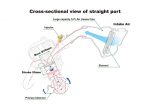
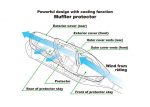
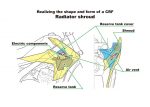
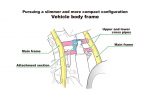
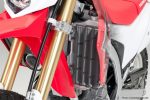
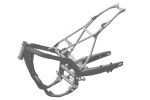
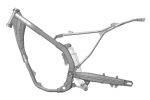
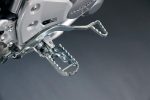
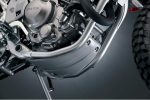
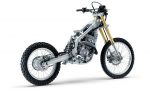
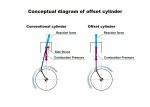
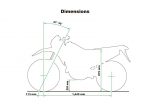
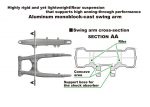
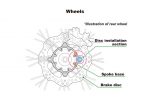
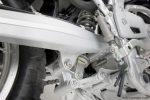
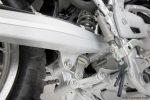
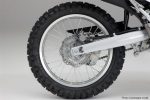
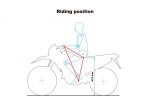
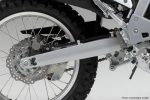
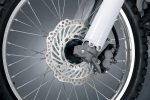
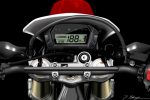
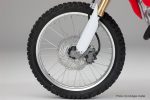
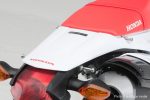
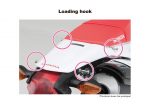
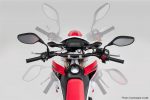
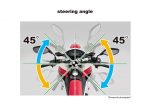
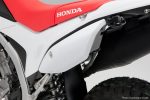
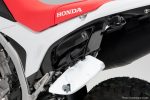
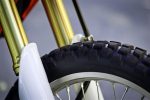



Wow! . . . No other motorcycling is more a a blast than a 250cc dual sport. Any less detracts from the thrill and any more is just plain too heavy. Just say NO! to trailering an off-road bike to the woods when you can drive it there instead.
Honda is standing alone offering a 250cc class dual sport to USA. Kawasaki no longer offers theirs in North America. Suzuki has only a carburetted 200cc available and their 650. Yamaha’s 250 is not as high tech nor durable as the Honda. For example, they engineered it with only a #428 chain instead of the more resilient #520.
Also let me compliment Chattanooga Honda for such a great inventory of products as well as really cool employees like Kevin who made my recent purchase a breeze.
its OCTOBER 2016!!!! any UPDATES???
until NOW I cant see anything NEW coming form HONDA regarding the CRF250L …. not even new informations about the new model 😉
Saw the 2017 250L in Long Beach yesterday at the motorcycle show. It’s a step up in performance from the 16′. specs from Honda:
First, the CRF250L: We’ve given it some great new updates for 2017. Some highlights: A larger throttle body improves the feel of the bike’s low- and mid-range power, as does the new muffler design, revised airbox, and larger diameter exhaust header. And check out its new graphic treatment, matched up to our CRF450R MX bike. The all-new CRF250L Rally gets the same updated engine as the standard 250L, but it also gets a larger fuel tank, totally new Dakar-style bodywork, handguards, a windscreen, skid plate and even more suspension travel. And both give you a great upright seating position that’s comfortable for longer rides, ideal for both urban traffic or out on the trail. They’re even available with optional ABS.
Honda has always made crap. Had one when I was a kid and the tranny locked up on me. I am so retarded I thought Honda got better so I bought a 2016 CRF 250L brand new. 600 miles quit working. month out of warranty. Has fuel, has spark, cleaned injector. Cant figure out why it wont start. Honda SUCKS.